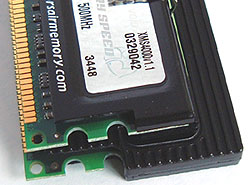 Gone are the plain-Jane flat aluminum heat spreaders of old, and in their
place are a new style of cast aluminum RAMsinks. The cast aluminum RAMsinks that accompany the CMX512-4000Pro
modules are taller, ribbed for larger surface area, and thermally bonded to
the DRAMs below.
Gone are the plain-Jane flat aluminum heat spreaders of old, and in their
place are a new style of cast aluminum RAMsinks. The cast aluminum RAMsinks that accompany the CMX512-4000Pro
modules are taller, ribbed for larger surface area, and thermally bonded to
the DRAMs below.
Each stick of memory is consequently a bit heavier than the
older heat spreader style, but still much lighter than a copper-heat spreader clad stick
of DDR.
Corsair thermally bond the RAMsinks to the DRAMs by way
of an adhesive thermal paste material. When the DIMMs are turned
on their edge it looks as though white thermal paste was used to
interface between the chips and the metal. The difference is of course that
the thermal paste as set, and now firmly bonds the two materials
together so there is no concern of white
material leaking down into the DIMM slot with time.
 |
| The CMX512-4000 DDR module in the foreground is
dwarfed by the new Corsair CMS512-4000Pro module in the back with its large cast aluminum RAMsink. |
While
this method reportedly improves thermal efficiency over frag tape, it also
means we cannot remove the
RAMsinks to have a peek at the markings on the DRAMs.
The ribbed RAMsinks get nice and warm with use, and on
a side note, pointing a fan in their direction did not
affect the overclockability of the sticks in any way.
 As we mentioned earlier, the LED lights on the top edge of each stick
aren't just there to hypnotize us with flashes of light. The
18
LED's
indicate which particular DRAM
chips are being accessed. As you can see by watching this short 9-second AVI
video clip (1.07MB) of the CMX512-4000Pro memory in action, the the LED's really do seem to act along the
lines of a tachometer.
As we mentioned earlier, the LED lights on the top edge of each stick
aren't just there to hypnotize us with flashes of light. The
18
LED's
indicate which particular DRAM
chips are being accessed. As you can see by watching this short 9-second AVI
video clip (1.07MB) of the CMX512-4000Pro memory in action, the the LED's really do seem to act along the
lines of a tachometer.
We didn't attempt to remove the RAMsinks, so we're not positive
what type of DRAMs are used on these modules, however, I think it's safe to assume that the
CMX512-4000Pro modules use the same Hynix HY5DU56822BT-D43 DRAM as the regular CMX1024-4000 modules
do.
When it comes to
DDR these days, we've been noticing that modules are being targeted towards
either high bandwidth or low latencies, but not necessarily both.
High speed DDR like
these 500MHz XMS4000 modules are not built for AMD rigs. Yes, I know there are AMD users
who can run their FSB's in excess of 250 MHz, but the performance hit due to the lax timings
will negate much of the benefit of running at a higher FSB. On the Intel side
of the fence things are a bit different; high bandwidth has always been more important to the
processor than latency, so the emphasis is squarely on memory capable of running at
high speeds (500MHz in this case).
With that said let's see how these babies overclocked in both the AMD
and Intel world!
